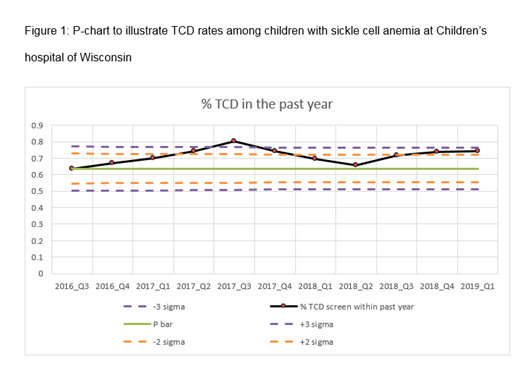
Objective: Published literature shows low and variable compliance with the recommended guidelines for care of children with sickle cell disease (SCD). Our objective was to use an electronic health record (EHR)-based registry to track and improve compliance with the recommendations for the pediatric population of SCD at our institution, using annual transcranial doppler screening (TCD) as an example.
Methods: We developed an in-EPIC real time registry for children with SCD in the year 2016 to enhance point of care and improve quality. Since 2017, we have been conducting plan-do-study-act (PDSA) cycles using the registry to improve TCD compliance. We extract data quarterly to examine TCD rates and share with the clinical team the list of children who have not received a TCD screening in the past 18 months. This allows the clinical team to provide case-management to reduce non-compliance. We recently added Child Life support to increase TCD compliance among children <7 years. We use control charts to examine TCD rates after the aforementioned interventions. We also continually refine the registry to broaden the provision of quality care to the patient population.
Results: One year into the registry, which we considered baseline and the start of the first PDSA cycle, 63% of children were compliant with the recommendation of an annual TCD screen. The TCD rates steadily increased to 80% by the third-quarter of 2017. We observed a dip in TCD rates by the second-quarter 2018 (66%), felt to be in part driven by failure of screening young children. Since the initiation of Child Life Support for young children, the overall TCD rates increased to 74% (first-quarter 2019). Our data demonstrate a sustained improvement in TCD rates since 2016 and meet criteria for special cause variation (Figure 1). We have recently added other metrics such as acute care encounters external to our institution, magnetic resonance imaging, and an indicator for active hydroxyurea use to the registry.
Conclusion: Use of an EHR-based registry to track and provide feedback on quality of care metrics such as annual TCD screening can result in sustained improvement in compliance with the recommended guidelines. Preliminary evidence indicates that Child Life involvement further improves TCD rates. Future work will determine if audit and feedback for other metrics added to the registry can improve compliance and improve outcomes.
Panepinto:NIH: Research Funding.
Author notes
Asterisk with author names denotes non-ASH members.

This icon denotes a clinically relevant abstract


